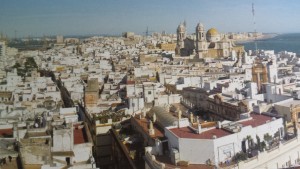Cadiz is a seeing city, a place which looks. Its myriad miradors or watchtowers face the ocean and the Americas, but also the  safe haven of the harbour in the Bay. There are the dominating twin towers of its cathedral, its golden dome easily seen from out at sea, though the building faces inward to the city, away from the storms. This still called the ‘new’ Catedral though it was begun in 1776, because the ‘old’ one, which burnt down, was an Alfonsine construction built in 1260. Even the latest new city, built outside the walls, on the land reclaimed from the lagoon, with its long beaches and high-rise apartments, has walls of windows and the look-out point on its high telefonica tower.
safe haven of the harbour in the Bay. There are the dominating twin towers of its cathedral, its golden dome easily seen from out at sea, though the building faces inward to the city, away from the storms. This still called the ‘new’ Catedral though it was begun in 1776, because the ‘old’ one, which burnt down, was an Alfonsine construction built in 1260. Even the latest new city, built outside the walls, on the land reclaimed from the lagoon, with its long beaches and high-rise apartments, has walls of windows and the look-out point on its high telefonica tower.
Living in a city on the edge of the known world probably encourages a propensity to look outwards, even if it just means getting prior warning of the oncoming wrath of an Atlantic storm. Cadiz has always been outward-looking and cosmopolitan in the way that port cities are and it’s been trading since Greek times. Most lucratively, it traded with New Spain in the 17th and 18th centuries. Much of the city’s architecture is from that period, though there are houses from earlier, plus medieval walls and gates and Roman and pre-Roman architecture ( the theatre is the second largest Roman theatre in the world ). But the style along the streets is mainly neo-classical or Isabelline gothic, the candy-colours adding a touch of gaiety.
a propensity to look outwards, even if it just means getting prior warning of the oncoming wrath of an Atlantic storm. Cadiz has always been outward-looking and cosmopolitan in the way that port cities are and it’s been trading since Greek times. Most lucratively, it traded with New Spain in the 17th and 18th centuries. Much of the city’s architecture is from that period, though there are houses from earlier, plus medieval walls and gates and Roman and pre-Roman architecture ( the theatre is the second largest Roman theatre in the world ). But the style along the streets is mainly neo-classical or Isabelline gothic, the candy-colours adding a touch of gaiety.
Gaditanos like and are used to the exotic and they like to look. So the old city has some of the finest window architecture outside of a Gaudi building.

Balconies teeter above narrow, chasm-like streets which are shaded for all but only a couple of hours a day. Or they open upon one of Cadiz’ lovely garden squares, Plaza Mina or Plaza Candelaria, stocked, like the Parque Genoves at the tip of the city’s land mass, with exotic plants brought back by Columbus and the other ocean voyagers.
Or there are the market ‘squares’, just open spaces really, like the pretty  flower market or by the newly refurbished Market Hall (great for fresh fish). Opening upon them all are elaborate balconies, decorated even further with masks during Carnaval in February.
flower market or by the newly refurbished Market Hall (great for fresh fish). Opening upon them all are elaborate balconies, decorated even further with masks during Carnaval in February.
Land values are, in such a restricted area, very high, which is why the Gaditanos have built upwards to create the cavernous streets. This means that Cadiz is one of the most densely populated cities in Europe, though it population is actually less than 120,000 people. Whilst granting the city great charm, only possible in places where development and building is restricted, it also limits new economic activity. So, although the Bay area communities of Puerto Real and San Fernando are flourishing, there is still a drain of young Gaditanos away from the area.
 If you really want to view the ocean and look back at the city why not walk out to the disused fort of San Sebastian, it’s open to the public (though take water with you on a Summer’s day, it’s much further than you think when looking at it from the shore). And beware, it’s not the place to be stranded in a storm. If you see one coming I suggest hurrying back to the comforting shelter of the streets.
If you really want to view the ocean and look back at the city why not walk out to the disused fort of San Sebastian, it’s open to the public (though take water with you on a Summer’s day, it’s much further than you think when looking at it from the shore). And beware, it’s not the place to be stranded in a storm. If you see one coming I suggest hurrying back to the comforting shelter of the streets.
If you would like to read more about the beautiful, historic city that is Cadiz try Cadiz in the Rain Mirador Wanted: Book Researcher…


 RSS – Posts
RSS – Posts